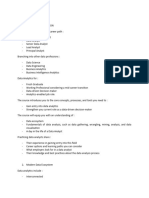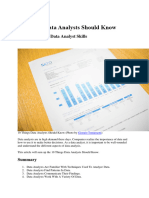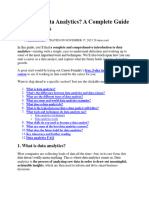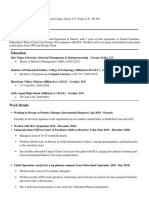0% found this document useful (0 votes)
69 views9 pagesIntroduction To Data Analytics
This document outlines the fundamentals of data analytics, including its definition, importance, and the role of a data analyst. It details key responsibilities, required skills, and potential career pathways in the field. Additionally, it provides a roadmap for becoming a successful data analyst, emphasizing essential skills and tools.
Uploaded by
Alaaanees2010Copyright
© © All Rights Reserved
We take content rights seriously. If you suspect this is your content, claim it here.
Available Formats
Download as PDF, TXT or read online on Scribd
0% found this document useful (0 votes)
69 views9 pagesIntroduction To Data Analytics
This document outlines the fundamentals of data analytics, including its definition, importance, and the role of a data analyst. It details key responsibilities, required skills, and potential career pathways in the field. Additionally, it provides a roadmap for becoming a successful data analyst, emphasizing essential skills and tools.
Uploaded by
Alaaanees2010Copyright
© © All Rights Reserved
We take content rights seriously. If you suspect this is your content, claim it here.
Available Formats
Download as PDF, TXT or read online on Scribd
/ 9






















































































